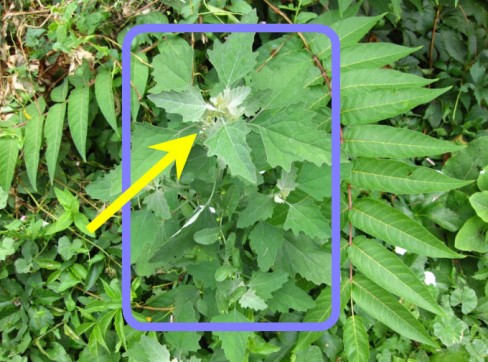Now that it’s summer, there are lots of forage-able treats in the urban landscape, and today I wanted to highlight a couple of my favorites: Daylily flower buds and Lamb’s Quarters leaves. I often take walks on my lunch break through the neighborhoods near where I work, and munch on these, raw, as I encounter them (picking mindfully, of course). The daylily buds have an unusual, sort of mild spicy taste that grows on you, and the Lamb’s Quarters leaves taste very similar to spinach, and can be eaten either raw or cooked like spinach.
Just be sure to avoid plants growing near busy roadways or areas that are likely to have been sprayed with pesticides (like the grassy areas of parks).
Here’s what Alan Hall’s Wild Food Trailguide says about Daylilies:
Unopened flower buds, opened flowers, and withered flowers may be eaten. Unopened buds boiled in salted water for a very few minutes make an excellent cooked vegetable. Buds and opened flowers can be dipped in batter and fried like fritters. Both open and withered or dried flowers can be added to soups and stews, where they provide body and impart an interesting flavor. The flavor of dried and freshly collected flowers is somewhat different and they should be tried both ways. If flowers are dried for later use they should be soaked until soft in cold water before using. The softened dried flowers will have a slightly genatinous quality. The small tubers can be dug anytime during the period when the ground is unfrozen. Only firm, young tubers should be collected. After digging they should be washed clean of clinging earth and freed of small rootlets. Boiled in salt water they have a flavor reminiscent of sweet corn. They can be eaten raw as a salad and are sweet and crisp with a pleasant nutty flavor.
Lamb’s Quarters is a member of the Goosefoot family and a relative of Quinoa. You’ll find it growing mainly in poor, disturbed soils and in other weedy areas.
Here’s what Alan Hall’s Wild Food Trailguide says about Lamb’s Quarters:
Lamb’s Quarters leaves make an excellent potherb that is considered by many people to be superior to spinach. And like spinach, it loses a great deal of bulk in cooking so an ample supply should be collected. Young plants are best, but this plant continues to put up new shoots that can be used well into summer. The leaves are not bitter, and the cooking water need not be changed. Seeds can be collected by rubbing them from the spikes into an appropriate container. They are available from the time they are dry in the fall until they drop, often well into winter. The seeds are extremely abundant and it is possible to gather several quarts in less than an hour. Winnow out the husks and trash, and then grind the seed into flour. Since the seeds are very hard, grinding can be difficult: the seeds slip away from the grinders in hand mills (although kitchen blenders work well). To get around this, it helps to boil them until they are soft, then mash up the softened seeds and allow them to dry out before grinding. The flour produced from the seeds is very black. It is good for making pancakes, muffins, etc., and can be used by itself or mixed with wheat flour. The mush produced by boiling seeds until they are soft can be eaten as a breakfast cereal or emergency food.
And don’t forget about Purslane! It’s another nutritious weed with a lovely mild lemon flavor that’s also growing abundantly at this time of the year.


































Can lamb’s quarters be eaten raw? Or should they be cooked tobe safe?
They can be eaten raw. Cooked probably tastes better though.